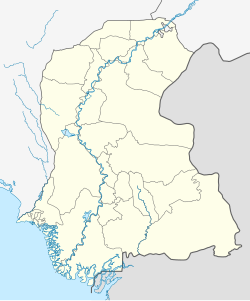| Battle of Aror | |||||||
|---|---|---|---|---|---|---|---|
| Part of Umayyad conquest of Sindh | |||||||
 Indus River near Aror | |||||||
| |||||||
| Belligerents | |||||||
| Umayyad Caliphate | Kingdom of Sindh | ||||||
| Commanders and leaders | |||||||
| Muhammad ibn al-Qasim | Raja Dahir † | ||||||
| Strength | |||||||
| 20,000 | 20,000–25,000 [2] [3] 50,000 (modern estimates) | ||||||
Location within Sindh | |||||||
The Battle of Aror took place in 712 AD between the Umayyad forces under Muhammad ibn al-Qasim and the army of the Brahmin dynasty of Sindh under Raja Dahir. At the Battle of Aror (Rohri), Muhammad ibn al-Qasim was met by Dahir's forces and the eastern Jats in battle. [4] It was the last military conflict involving Raja Dahir, whose army was defeated by the Umayyads near the Indus River, and Dahir was killed.

